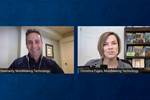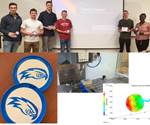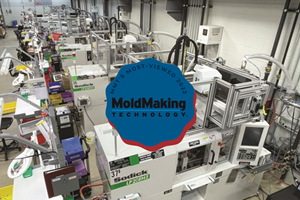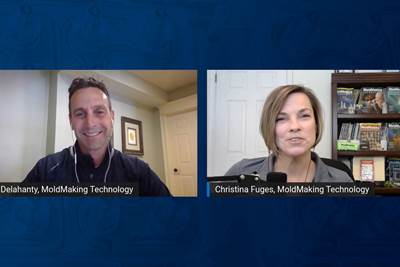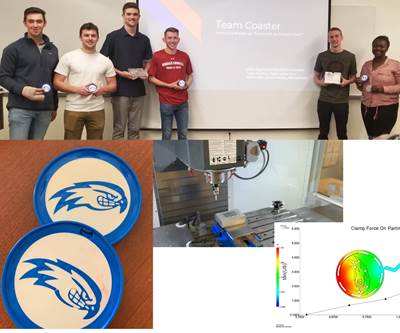
Structured mold design training programs will help students become future moldmaking employees who are able to develop tooling solutions to meet the industry’s efficiency and cost-effectiveness demands. Source (All Images) | UMass Lowell
The moldmaking industry is experiencing numerous challenges, from the evolving global economic and social landscape to rising environmental concerns and the need for sustainable solutions. To tackle these obstacles, moldmakers must first confront the scarcity of skilled labor.
Here is a summary of insights and advice on moldmaking and mold engineering workforce challenges from a recent scientific article published in the Sustainability MDPI journal.
Workforce Challenges
The mold manufacturing industry has unique workforce challenges because of its highly specialized nature and reliance on traditional apprenticeship systems. Recruitment and retention pose significant hurdles because finding employees with the necessary technical expertise can be arduous and costly.
Furthermore, retention is hampered by a lacking awareness among workers regarding long-term career prospects in the industry. Additionally, the speed of technological advancements and the ever-changing customer demands only broaden the skills gap and require investment in training and education initiatives tailored to the evolving needs of the industry.
The moldmaking industry can navigate its workforce challenges and thrive by implementing comprehensive strategies that prioritize education, diversity and inclusivity.
Apprenticeship-based training remains integral, which highlights the industry’s resistance to complete modernization. Promoting diversity and inclusivity is a must to foster innovation and attract top talent while addressing generational change, which requires strategic initiatives to appeal to younger professionals. The moldmaking industry can navigate its workforce challenges and thrive by implementing comprehensive strategies that prioritize education, diversity and inclusivity.
Educational Challenges
Traditionally, moldmakers acquire their skills through on-the-job training, acquiring expertise over time. However, this approach has resulted in an aging and homogeneous workforce without formal education opportunities. This lack of structured training programs means employees face challenges in meeting business demands for efficiency and cost-effectiveness. Also, a shortage of university-level courses focusing on mold design and manufacturing leaves engineers ill-prepared for the industry’s specific needs.

Students need practical skills to be successful when they enter the moldmaking workforce. They also need to be exposed to industry resources like MoldMaking Technology.
Technical high schools, potential talent pools for the industry, struggle to keep pace with technological advancements due to limited resources. So, graduates often lack practical skills, leading to a disconnect between industry requirements and their capabilities. The shortage of experienced professionals willing to teach makes matters worse, compromising the quality of education.
Finally, insufficient collaboration between educational institutions and industry leads to a skills mismatch, as curricula fail to align with industry needs. This mismatch hampers the efficiency of engineering graduates, as theoretical knowledge often does not translate into practical skills required in the workplace. Experiential learning and ongoing training are necessities.
Political-Economic-Social-Technological-Legal-Environmental (PESTLE) Analysis
This research used the PESTLE framework approach to formally analyze the moldmaking industry and its workforce challenges. Following is a summary of the research’s main takeaways:
P - Political Perspective
- Global trade policies and geopolitics influence competition and domestic wages.
- Potential reshoring driven by policies like the Inflation Reduction Act.
- Government regulations, especially related to labor and environment, impact reshoring and innovation.
E - Economic Aspects
- Rising cost pressures affect profitability and skilled worker retention.
- Customer demands for intricate molds may not always translate to higher profitability.
- Skills gap challenges in sourcing personnel capable of manufacturing complex molds.
S - Social Perspective
- Negative perception of manufacturing discourages young workers, accelerating workforce aging.
- Lack of accessible training programs hampers workforce skills acquisition.
- Negative and ill-informed perceptions of plastic and its environmental impact affect the industry.
T - Technological Aspects
- Automation and smart manufacturing support industry growth but require continuous upskilling.
- Simulation tools can be costly and not always accessible to small and medium companies.
- Not all moldmaking processes can be automated, requiring significant contributions from skilled workers.
L - Legal Landscape
- Stringent safety regulations and labor laws impact competitiveness and training costs.
- Immigration restrictions may exacerbate labor shortages.
E - Environmental Concerns
- Sustainability demands impact materials, processes and competitiveness.
- Lack of clarity around sustainable strategies and actions to support manufacturers’ net-zero carbon goals.
Recognizing the importance of experiential learning and ongoing training, the industry must invest in professional development initiatives to empower the workforce to adapt to evolving technologies and drive innovation in moldmaking.
Overcoming these challenges requires a strategy centered on increased profitability, which includes a focus on cost reduction, especially since raising mold prices is not viable. Cost reduction and improved quality can be simultaneously realized by leveraging technological advancements. For example, establishing a smart mold factory through data-driven engineering, digital twin implementation and automation in design, machining and measurement. It is essential to state that directly pursuing cost reductions does not improve productivity and competitiveness.
Here is a comparison of the moldmaking industry’s current status with a desired future.

Future Outlook
Overall, the research shows that the moldmaking industry faces significant workforce and technological challenges on a global scale. To remain competitive, mold builders must prioritize investments in talent attraction, skills development and technology adoption, including automation and digital twin models to enhance efficiency and competitiveness.
However, for technological advancements to bear fruit, educational programs at various levels must support practical training, simulation, data analysis and robotics. Collaborative efforts between educational institutions and industry players are essential to effectively tailor curricula and training initiatives to meet changing needs. And while governmental and non-governmental support remains essential, governments must also prioritize technology advancement and workforce development initiatives.
Click here to access the full version of the research paper.
Related Content
How to Improve Your Current Efficiency Rate
An alternative approach to taking on more EDM-intensive work when technology and personnel investment is not an option.
Read MoreMold Builder Uses Counter-Intuitive Approach for Mold Challenges
Matrix Tool Inc. answers customers’ hard questions with creative solutions for cavity spacing, tool sizing, runner layout and melt delivery that reveal the benefits of running in a smaller press size at lower cavitation but higher yield.
Read MoreMMT Chats: Solving Schedule and Capacity Challenges With ERP
For this MMT Chat, my guests hail from Omega Tool of Menomonee Falls, Wisconsin, who share their journey with using enterprise resource planning (ERP)—and their people—to solve their schedule and capacity load monitoring challenges.
Read MoreTackling a Mold Designer Shortage
Survey findings reveal a shortage of skilled mold designers and engineers in the moldmaking community, calling for intervention through educational programs and exploration of training alternatives while seeking input from those who have addressed the issue successfully.
Read MoreRead Next
Video: Mold Design, Engineering and Virtual Learning
Christina Fuges and Ryan Delahanty chat with Don Smith of Scholle IPN and Davide Masato of UMass Lowell about COVID-19, education, mold design and more in the virtual video series “What's New and What Works in Mold Manufacturing.”
Read MoreHow to Learn Mold Design Virtually
Plastics Engineering program instructors share their strategies for successful virtual learning for hands-on injection mold design.
Read MoreGlobal Perspective on Next-Generation Mold Engineers
An assistant professor for a university plastics program summarizes a global panel discussion on the next generation of mold builders and engineers.
Read More

